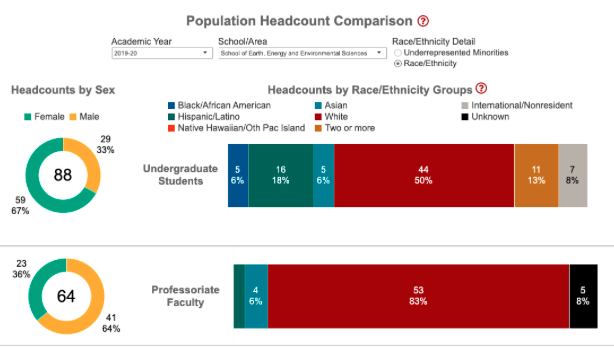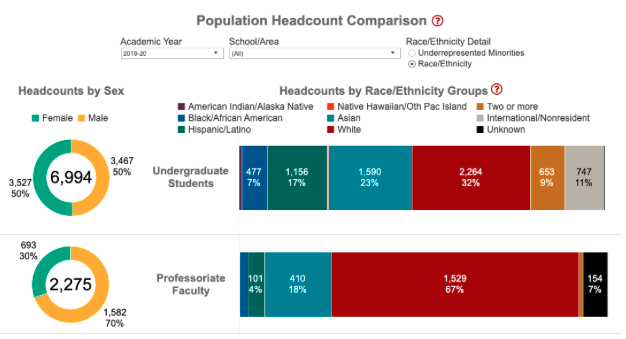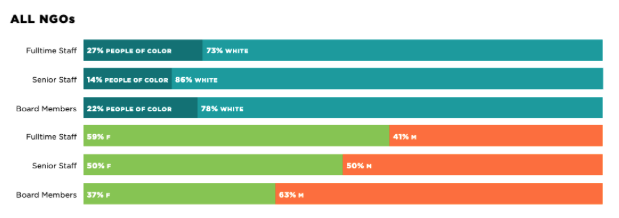A meme called “Earth Systems Starter Pack” was posted on the Stanford Facebook meme page in November 2019. Gathering more than 300 likes and 100 comments, the meme included photos such as the Patagonia logo, Teva sandals and Nalgene water bottles, all attributes of a “typical” white environmentalist who grew up backpacking in national parks and wears high-end outdoor clothing brands. Outdoor recreation has historically been dominated by white people because of cost barriers, privilege and cultural norms.

Throughout the United States and at Stanford, environmental fields have historically been dominated by white students, and studies show little improvement in diversity over the past 40 years. The white-dominated outdoorsy environmentalist identity translates to an equally white-dominated study of environmental sciences. Even though students of color are not absent from environmental spaces at Stanford, white students have the loudest voices and the largest presence. White students can feel confident that they belong in these spaces while students of color might feel like visitors or even intruders.
I am a Chinese-American earth systems student and I’ve never owned a Patagonia quarter-zip or a pair of Teva sandals. My parents never took me skiing because they had never skied before, and it was very expensive. I didn’t see any aspects of my own identity in the meme. Though it was meant to be humorous, the meme highlighted exactly how marginalized students can feel left out of a mainstream white environmentalist culture.
The world’s climate problems are continually intensifying, and we are rapidly heading toward a point of no return. Without diversity in the environmental sciences, valuable knowledge is missing to help solve one of the greatest challenges of our time. Researchers Douglas Medin and Carol Lee argue that diversity improves scientific development, citing examples where indigenous knowledge about sustainability have broadened scientific theories. This lack of diversity is therefore detrimental to creativity and innovation in a field that has huge problems to solve.
Furthermore, the lack of diversity in the School of Earth, Energy and Environmental Sciences (SE3) that affects a sense of belonging for undergraduates of color has broader implications for academia and professional careers in the environmental sciences. Stanford boasts a relatively diverse student body, yet students of color continue to feel marginalized in environmental spaces.
In a widely-read opinion piece titled, “#StanfordEarthSoWhite,” earth systems alumna Whitney Francis ’19 critiqued the mainstream, predominantly white environmentalist culture the School of Earth embodies. Francis graduated in 2019, and I was able to interview her and hear her reflections on the Earth Systems program.

Francis is black and Japanese and served as a student advisor for the earth systems program in 2018-19. Despite being an involved member of the community, she felt out of place.
“Even as I got to be more comfortable with earth systems, that feeling of being other, or feeling like my experience was different from everyone else’s was always still with me no matter how close I got to everyone,” she said.
I kept hearing these frustrations voiced over and over by my peers, so I wanted to see the statistics for myself. The overwhelming whiteness we’ve experienced was validated by the data dashboard from Stanford’s initiative for Inclusion, Diversity, Equity and Access in a Learning Environment (IDEAL).
The numbers don’t lie.
Of the three undergraduate schools, SE3 has the largest percentage of undergraduate white students by far, with 50%, almost double the percentage in the School of Engineering and 10% more than the School of Humanities and Sciences.
The biggest discrepancy in undergraduate representation in the SE3 is the Asian population. Asians make up 23% of the overall undergraduate student body, while making up only 6% of the SE3. Only five of the 88 undergrad students in the SE3 are full Asian across four different majors. To know that I single-handedly represent 20% of all Asian undergrads in the SE3 is remarkable, to say the least. It’s moments like these that have made me question if I belong here, why people like me aren’t in this field and if this is even a space where I can succeed.

(source: Stanford IDEAL dashboard)

(source: Stanford IDEAL dashboard)
Students’ sense of belonging is also impacted by the identities of the faculty advisors and mentors around them. SE3 undergrads of color often struggle to find faculty they share a background with because the faculty statistics in the SE3 are even more homogenous than the undergrad ones are: 83% of SE3 faculty are white, compared to 67% across the University.
“Faculty diversity is so important because if you don’t see yourself reflected in a space, that sends a very clear message that you don’t belong, or that your perspective is not valued,” said Francis.
Without diverse faculty, teaching perspectives are also narrowed and important histories can be overlooked. Coterminal master’s earth systems student Talia Trepte criticized the earth systems curriculum thusly:
“You can’t talk about sustainable fashion without going back and acknowledging that the foundation of our cotton was slavery. I don’t think you can look at the national parks system without realizing a lot of those places used to have indigenous communities in them that were driven out. It’s impossible to talk about island ecologies without talking about how U.S. imperialism erased and changed indigenous cultures and enforced militarism. Those conversations don’t happen nearly as much in Earth Systems as some of us wish they did.”
Among students of color, there has been a consistent demand for curriculums that better acknowledge the role of people of color and indigenous peoples in environmental movements, and these perspectives would be better represented with more faculty of color.
There has been great work done by environmental justice student groups such as Students for a Sustainable Stanford (SSS) and the Environmental Justice Working Group, but an environmental justice curriculum has yet to be adopted into formal curriculum within the SE3.
The disproportionately white numbers don’t stop at Stanford. A lack of diversity in environmental fields is common all over the US. According to data from the Integrated Postsecondary Education Data System (IPEDS), 68.7% of environmental science degrees were awarded to white students in 2017, compared with 41.5% in the biological and physical sciences.
Upon graduation, students of color face an even whiter professional landscape. Environmental diversity working group Green 2.0 found that almost three-quarters of full time staff working for US environmental NGOs as well as 86% of senior staff were white in a 2017 survey . All these factors can make it discouraging for students to continue pursuing environmental careers.

Faculty perspectives
Gabrielle Wong-Parodi, an assistant professor in earth systems science, spoke to me about her path to academia. Wong-Parodi completed her undergraduate, master’s and Ph.D. degrees at UC Berkeley. Reflecting on her journey as a Chinese-American woman, she acknowledged the many female mentors that have supported and inspired her.
“If I didn’t have those female mentors, I don’t think I would be here, to be honest,” she said. “I needed those role models in my life to show me that I could do it, and to encourage me.”
Wong-Parodi stressed that it is important for students to have mentors they can relate to and feel comfortable with.
“There is a huge power dynamic between faculty and students,” she said. “If that person seems less approachable based on their gender or place of privilege or affluence, I would imagine it’s even more difficult to feel secure about your place in academia.”
Why is #StanfordEarthSoWhite?
“For first-generation college students or children of immigrants, engineering is a more attractive path,” said Lupe Carrillo, director of the SE3 Office of Multicultural Affairs (OMA). “There are very clear careers to pursue, whereas the earth and environmental sciences haven’t created as much of a narrative around that. Although there are many fulfilling career opportunities in environmental fields, they may offer less financial security than engineering or medicine, which can deter students who don’t have as much of a financial safety net.
Another culprit for #StanfordEarthSoWhite is the history and culture of environmental movements. People of color have been intentionally excluded from environmental spaces throughout history. The creation of U.S. national parks forced indigenous peoples off their own lands and reserved them for only people with wealth and privilege. Environmental racism, the disproportional impact of environmental hazards upon people of color, is real and can impact the relationships people have with the outdoors and nature.
Additionally, there are huge barriers to outdoor recreation, such as time, money, equipment and knowledge. If those activities aren’t something someone grows up doing, entering those spaces can be uncomfortable and intimidating.
So what has the School of Earth been doing to address these issues? The answer is not much.
In 2010, Jerry Harris, a geophysics professor and the only black faculty member in the entire SE3, founded the OMA. Harris is now an emeritus professor, leaving the SE3 with zero active black faculty.
The main focus of the office has been to diversify the pipeline into academia, according to Carrillo. The OMA sponsors the Summer Undergraduate Research in Geoscience and Engineering (SURGE) program, which invites low-income, minority students from other universities to participate in summer research with SE3 Ph.D. students and professors. The OMA has done little to address diversity at the undergraduate level until recently, with the launch of a new “Stanford Earth celebrates” series, which kicked off Black History Month by highlighting black scholars in environmental fields.
“In terms of reaching the undergrad community, we have that focus now,” said Carrillo.
However, some students are doubtful, such as Francis, whose challenging experiences have given her a less optimistic mindset.
“I have a lot of mistrust in the School of Earth and the administrators because at the end of the day I haven’t seen them putting their best foot forward and putting in an effort to begin to go in the right direction,” she said.
An earth systems starter pack for students of color?
Students of color in earth systems come from so many backgrounds, it would be impossible to encompass their identities in a single meme. However, there are unique shared experiences for students of color in earth systems that can be highlighted.

Many students shared that their inspiration to study earth systems came from their own cultural backgrounds and identities, such as Mirielle Vargas, a Latina earth systems undergraduate from the southern Californian town of Santa Paula.
“It’s pretty farmworker heavy, a Latino community … because of that, that was what I knew about environmental science,” Vargas said. “You know, like pollution, air pollution, pesticides, runoff, agriculture and ways to make it better, like sustainable agriculture.”
Her inspiration to study Earth Systems stems more from a concern for environmental justice than conservation or hard science.
Trepte was also inspired by their upbringing to study earth systems. Trepte is black, native Hawaiian and white and grew up going to the ocean almost every day in Hawaii.
“Without that cultural tie, I don’t know if I would have been drawn in the same way to an interdisciplinary program like earth systems,” they said.
Trepte and Vargas also share the hesitation they experience from their own families, who aren’t totally on board with them studying environmental science.
Vargas jokes, “Every time I come home, my family is like, ¿Y qué vas a hacer? [What are you going to do?],” questioning her career prospects. Trepte has also fielded similar questions from their family, some of whom are skeptical of climate change.
In reality, there are a wide array of career opportunities in the earth sciences, but the path is not as streamlined as in other STEM fields. The skills learned in earth sciences can be applied to a number of fields such as research, scientific consulting, data analysis, nonprofits and policy work. It’s the SE3’s responsibility to help students understand the career possibilities in environmental fields and encourage more students to enter.
Moving forward
The SE3 needs to increase its efforts of creating intentional spaces for students of color to thrive in and feel welcomed. We need improved recruitment efforts for students of color, more faculty of color and introduction of formal environmental justice curriculum in SE3 majors.
That’s not to say there isn’t anything being done.
“I love the intention of earth systems, the earth systems program all around,” Trepte said. “Everyone there is really trying to foster a joyful community that tackles really tough issues. I do think that sometimes intention’s not enough.”
Even if intentions are present, they need to translate into actions. Diversity is important to scientific progress in any field, but especially in environmental sciences. It’s a problem at Stanford and beyond.
“The lack of diversity is such a loss for Earth Systems and the School of Earth because there are so many ways how our communities [of color] are resilient in the face of environmental injustice and climate change,” Francis said.
When diversity is lost, so are important perspectives and approaches that could be key to solving our climate problems.
Contact Jessica Mi at jess3965 ‘at’ stanford.edu.
The Daily is committed to publishing a diversity of op-eds and letters to the editor. We’d love to hear your thoughts. Email letters to the editor to [email protected] and op-ed submissions to [email protected].
Follow The Daily on Facebook, Twitter and Instagram
